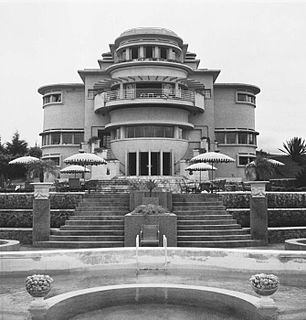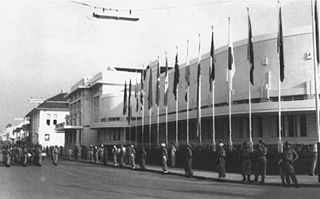
Bandung is the capital city of the Indonesian province of West Java. It has a population of 2,444,160 within its city limits, making it the fourth most populous city in Indonesia. Greater Bandung is the country's third-largest metropolitan area with over eight million inhabitants. Located 768 metres above sea level, the highest point in the North area with an altitude of 1,050 meters and the lowest in the South is 675 meters above sea level, approximately 140 kilometres southeast of Jakarta, Bandung has cooler year-round temperatures than most other Indonesian cities. The city lies on a river basin surrounded by volcanic mountains that provides a natural defense system, which was the primary reason for the Dutch East Indies government's plan to move the capital from Batavia to Bandung.

Streamline Moderne is an international style of Art Deco architecture and design that emerged in the 1930s. Inspired by aerodynamic design, it emphasized curving forms, long horizontal lines, and sometimes nautical elements. In industrial design, it was used in railroad locomotives, telephones, toasters, buses, appliances, and other devices to give the impression of sleekness and modernity.

Menteng is the south-central district of Central Jakarta, one of the administrative municipalities in the capital city Jakarta, Indonesia.

Villa Isola is an art-deco building in the northern part of Bandung, the capital of West Java province of Indonesia. Overlooking the valley with the view of the city, Villa Isola was completed in 1933 by the Dutch architect Wolff Schoemaker for the Dutch media tycoon Dominique Willem Berretty, the founder of the Aneta press-agency in the Dutch East Indies. The original purpose of the building was for Berretty's private house, but then it was transformed into a hotel after his death and now it serves as the headmastership office of Indonesia University of Education.

The architecture of Indonesia reflects the diversity of cultural, historical and geographic influences that have shaped Indonesia as a whole. Invaders, colonizers, missionaries, merchants and traders brought cultural changes that had a profound effect on building styles and techniques.

Braga Street is a street in the center of Bandung, Indonesia, famous in 1920s colonial Indonesia as a promenade street. A European ambiance of chic cafes, boutiques, and restaurants along the street propelled Bandung to attain the Dutch nickname Parijs van Java.

Albert Frederik Aalbers was a Dutch architect who created elegant villas, hotels and office buildings in Bandung, Indonesia during Dutch colonial rule in the 1930s. Albert Aalbers worked in the Netherlands between 1924 and 1930 and then migrated to the Dutch East Indies after which he returned to the Netherlands in 1942 due to World War II and political circumstances following Indonesian independence. During his stay in Bandung, in a period when the city was dubbed the city of architecture laboratory, a number of his buildings were considered architectural masterpieces. Aalbers' style was inspired by expressionist Frank Lloyd Wright and modernist Le Corbusier. In Bandung, the DENIS bank in Braga Street and the Savoy Homann Hotel in Asia-Afrika Street, still carry Aalber's ocean wave ornamentation.

Charles Prosper Wolff Schoemaker was a Dutch architect who designed several distinguished Art Deco buildings in Bandung, Indonesia, including the Villa Isola and Hotel Preanger. He has been described as "the Frank Lloyd Wright of Indonesia," and Wright had a considerable influence on Schoemaker's modernist designs. Although he was primarily known as an architect, he was also a painter and sculptor.

Merdeka Building is an art-deco building in Jalan Asia-Afrika, Bandung, Indonesia. Today it serves as a museum displaying collections and photographs of the Asian–African Conference, the first Non-Aligned Movement event, which was held there in 1955.

Dutch colonial architecture in Indonesia were built across the archipelago that once was known as Dutch East Indies. Most of the better and permanent colonial era structures are located in Java and Sumatra, which were economically considered more important during the Dutch imperial period. As a result, there are large number of colonial buildings concentrated in its cities. Plenty of old VOC era forts and warehouses are also scattered throughout the archipelago, particularly around Maluku Islands and Sulawesi. There are three Dutch colonial architectural styles:

Pieter Adriaan Jacobus "Piet" Moojen was a Netherlands-Indies architect, painter and writer. He studied architecture and painting in Antwerp. He lived and worked in the Dutch East Indies from 1903 to 1929. He was one of the first architects to implement Modernism in the Dutch East Indies. Moojen became widely known for his work on the Dutch entry at the Paris Colonial Exposition in 1931. He was active as an architect between 1909 and 1931.

New Indies Style is a modern architectural style used in the Dutch East Indies between the late 19th-century through pre-World War II 20th-century. New Indies Style is basically early modern (western) architecture, which applies local architectural elements such as wide eaves or prominent roof as an attempt to conform with the tropical climate of Indonesia.

The architecture of Jacksonville is a combination of historic and modern styles reflecting the city's early position as a regional center of business. According to the National Trust for Historic Preservation, there are more buildings built before 1967 in Jacksonville than any other city in Florida, but it is also important to note that few structures in the city center predate the Great Fire of 1901. Numerous buildings in the city have held state height records, dating as far back as 1902, and last holding a record in 1981.

Johannes Martinus (Han) Groenewegen was a Dutch architect who was active in the Netherlands and the Dutch East Indies, and subsequently, Indonesia from the 1920s to the 1960s.
Soejoedi Wirjoatmodjo was an architect in Indonesia who was active during the late 1960s and mid 1970s. In 1964, he was asked by President Sukarno to be in charge as chief architect for national architectural projects in the Jakarta. Soejoedi is considered to be the first native architect of the Post-Colonial period that is considered as a proponent of modernist architects and designers.

The Indonesian Ministry of Transportation Building is a historic building and a cultural property located in Jakarta, Indonesia. The building is currently the headquarter of the Indonesian Ministry of Transportation. The building, established as the headquarter of the Koninklijke Paketvaart-Maatschappij (KPM), was the first project of AIA Bureau, the biggest architecture consultant in the Dutch East Indies.

During the 17th, 18th, and 19th century, European nations began to consolidate naval routes into South East Asia, whereby India was used as the main trade route for ships to stop and refuel or trade. Over this time, mostly during the 19th century, various Western Colonies began to gain influence various countries and construct colonial architecture in Southeast Asia. This period saw many classical buildings constructed in the neoclassical and French Colonial style of architecture.

Historic Hotels of America is a program of the National Trust for Historic Preservation that was founded in 1989 with 32 charter members; the program accepts nominations and identifies hotels that have maintained their authenticity, sense of place, and architectural integrity. As of June 5, 2015, the program included over 260 members in 44 states, including the District of Columbia, Puerto Rico, and the U.S. Virgin Islands.
















